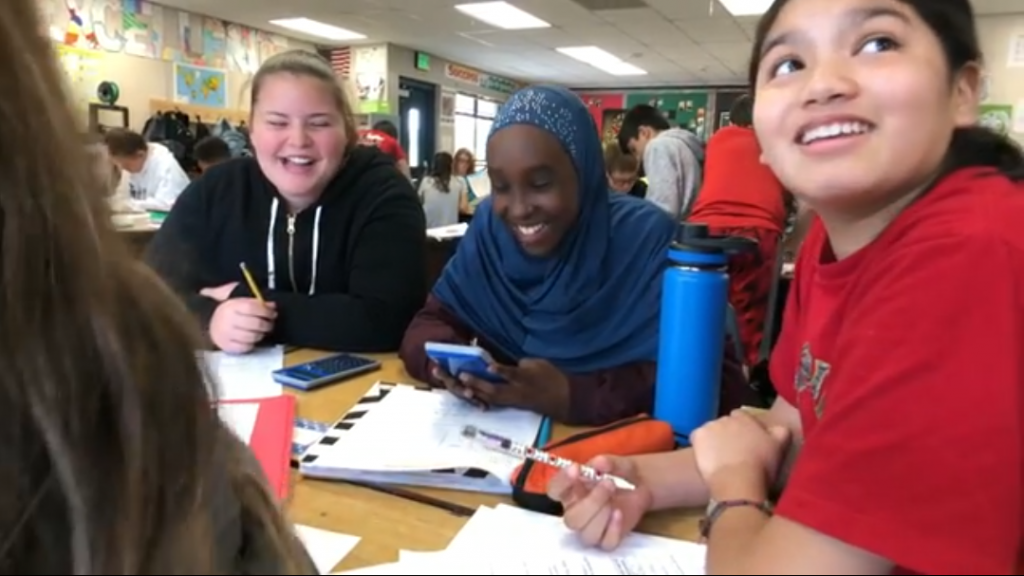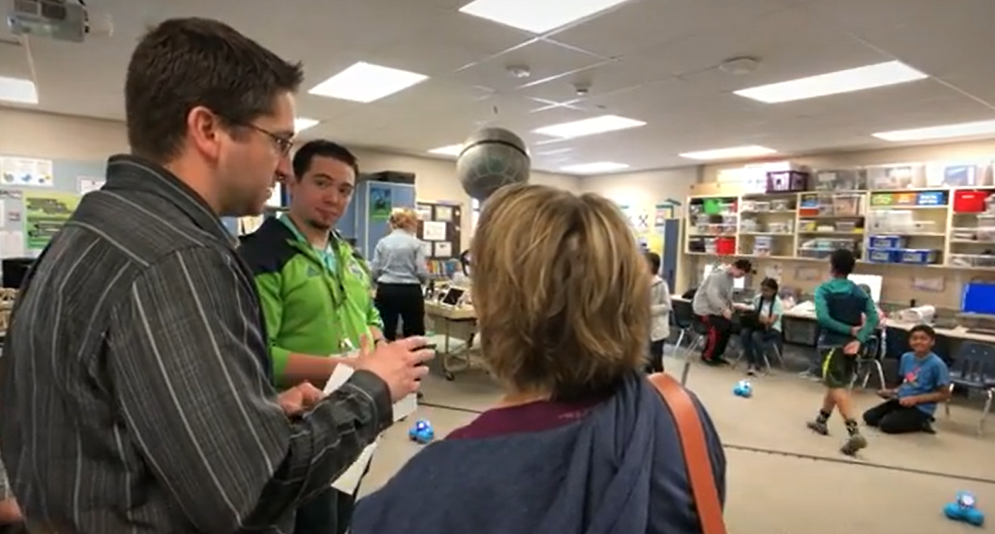
Meeting Students Where They’re At
So often school has a one-size fits all approach. This is partially because individualizing content and activities is hard and time-consuming. On the other side of this coin, a lot of students aren’t getting the opportunities that they deserve to access their education. This is a broad topic and way beyond the scope of one blog post. With this in mind, I’d like to narrow down to looking at ISTE Standard 3 which focuses on addressing digital learning needs, but I’d like to broaden the discussion a little from there to include STEM since I can speak to this from my overall background and experiences. While I’m not sure how to individualize STEM education for every student in a given classroom setting, I do think we can do little things to move beyond a singular approach so that more students can have the opportunity to access this learning. Culturally relevant pedagogy can help more students access standards-based content in a manner that’s developmentally appropriate for them. And, per the Edutopia article entitled Making STEM Accessible to All (Reed, M. 2018), “But there are benefits to being exposed to STEM in the classroom beyond test scores, such as improved problem-solving skills, creativity, mental alertness, and teamwork and collaboration. As leaders, we must ensure that every student has a chance to reap these benefits.”
International Society for Technology in Education (ISTE) Coaching Standard 3
3) Collaborator: Coaches establish productive relationships with educators in order to improve instructional practice and learning outcomes. Coaches:
3a. Establish trusting and respectful coaching relationships that encourage educators to explore new instructional strategies.
3b. Partner with educators to identify digital learning content that is culturally relevant, developmentally appropriate and aligned to content standards.
3c. Partner with educators to evaluate the efficacy of digital learning content and tools to inform procurement decisions and adoption.
3d. Personalize support for educators by planning and modeling the effective use of technology to improve student learning.
Essential Question
How can instructional coaches and professional development providers partner with other educators to engage and support all students with culturally relevant digital and STEM learning content that’s both developmentally appropriate and aligned to content standards?
Providing STEM Opportunities For All Students in the Classroom
I’ll be honest, I struggled with how to individualize learning for students in my classroom. I have yet to find an approach that accomplishes this without exponentially increasing the teacher’s workload. This did get me thinking about how to better reach my students for whom the generic approach wasn’t working, though. I tried to consider how to integrate reading in a way that students reading 2-3 levels below grade-level could still participate and be successful because reading to learn is where students with learning disabilities most often struggle (Hall, T.E., Cohen, N., Vue, G., Ganley, P., 2015). In my experience, the same was true for writing to learn and for the math involved. I also partnered, paired, and grouped very carefully with this in mind. How were students balancing each other out skill-wise so that their team could learn and perform at a higher level than any of them could on their own (we transformed our table groups into “learning teams”). In support of my English learners and special education students, this often meant collaborating with the corresponding teachers. Could we move content around for a special event or flex the schedule? Could the teachers and students try pushing into my classroom for a unit? Could the various groups of learners work on the content in parallel and then come together for a culminating activity? Getting creative is key and often not as much work as one might think… just intimidating when it comes to the hardest part: getting started.
STEM Instructional Coaching in Support of All Students
As an instructional specialist and coach, I tried to continue collaborating with other specialists so as to better reach more students. The special education and English learner teachers and I collaborated on activities that were unique and special just for their students. We also worked with classroom teachers that were willing to make adjustments wherever possible. I branched out to working with the music and PE teachers when I could. According to Basham, J.D. and Marino, M.T. (2013), “The success of students with disabilities who participate in general education STEM classes is directly linked to teachers’ abilities to understand students’ unique learning need and problem-solving abilities (Marino, 2010).” Technology is incredibly powerful when it comes to helping students access learning in a variety of ways. If they can’t write then can they speak to text? Can we use a text reader for reading? How about video access? Screen recorders? All different ways for students to show they learned the STEM content itself as opposed to testing them on other skills like communication, reading, writing, etc.
One thing I learned along the way is that there are a lot of students who will find their first big successes in STEM-based activities, if they are given the chance. I first saw this in my first year teaching. “J” was special education student that struggled with reading and writing in particular. Traditional school was a chore, though, from which he derived no joy and was barely passing, except, when it came to STEM oriented activities that possessed a technology component. Here he excelled. I tried to nurture this where I could but opportunities were limited at that time. In spring, when I received a flyer about the new district technology academy opening up, I saved a copy and handed it to his mom and implored her to look into it for him. She did, he blossomed, and eventually became one of the IT leads for the district, went on to work for a leading technology company, developed brilliant anti-malware software in his free time that he sold to a company, and now serves as a lead network administrator for a leading nonprofit. “S” was another student who had Tier 3 interventions and so missed most classroom content time yet excelled. I was able to engage and support him in our after-school robotics club where he became a leader, one of the most adept programmers, and a brilliant designer. He figured out challenges that stumped the adults and was able to do so remarkably fast. With regard to anything mechanical, he was absolutely brilliant. The special education teacher and I created as many unique and special opportunities for him as we could and he shined.
Students like “S” and “J” are examples in the current educational system where essentially taking our metaphorical “fish” that are gifted swimmers and only testing them on their ability to “climb trees”. The system is hardwired, mammoth, and often set in stone so it’s difficult for teachers to make adjustments but it’s worth doing what we can where we can. Getting creative with the standards is one way so that students can demonstrate their knowledge in a variety of contexts. I kept a clipboard with a roster on the wall for each content area and would grab the appropriate one in a hurry if I noticed an opportunity for a quick data point in the midst of a unique learning opportunity that I hadn’t anticipated. Adjusting schedules where we can around the edges is another place that we can make small changes that add up over time and if enough teachers speak out then larger changes can occur, e.g. in my previous district, over many years and much advocacy science instruction eventually became protected time during the K-6 elementary school day.
Professional Development Provider: How Do I Support All Students?
These are all connections based on my current research connected to my previous educational experience. This all comes back around to my essential question but from my current context as a professional development provider. Every context is so different, and I my experience is limited. Even the most experienced teacher cannot hope to experience even 1% of possible contexts out there. Knowing this is to recognize that every educator is the expert on their teaching context, so, as a professional development provider, how can I support and empower them? I think looking at the research, identifying patterns of success, and truly listening to each educator in order to learn from their experience are good places to start. Teachers want professional development that’s relevant, treats them like professionals, and is delivered by someone who understands their experience (Bill & Melinda Gates Foundation, 2014). Some things I’ve noticed so far, most teachers did not have any STEM training as part of their teacher certification process so some initial basics are needed in order to help them get up and running. Growing teacher confidence is key and even more important than ability. We can always learn alongside the students as we go. Planting seeds, encouraging ideas, and validating early thinking are some ways to encourage teachers to support all students in STEM education efforts.
Drawing Conclusions for a Truly Broader Impact
I’ve written mostly to special education examples because that’s where my current research led me but there are so many broader examples to explore. English learners need additional ways to access content and it needs to be okay for them to find ways to show what they know via native language when possible and native culture when appropriate. Student minorities need to see themselves and their cultural values reflected in the learning and career opportunities so that they can truly see themselves growing up into a variety of STEM roles. Girls need supports and encouragement that are at least as supportive and encouraging as boys often receive in these areas. By providing a variety of ways for students to access their learning and working to make STEM both available and accessible to all learners, we can start to make small steps together as educators to show that all means all and truly starts with meeting each student as an individual where they are at.
References
- Basham, J.D. & Marino, M.T. (2013). Understanding STEM Education and Supporting Students Through Universal Design for Learning. Teaching Exceptional Children, Vol. 45 (No. 4), pp. 8-15.
- Bill & Melinda Gates Foundation. (2014, December). Teachers Know Best: Teachers’ Views on Professional Development. Bill & Melinda Gates Foundation. Retrieved from http://k12education.gatesfoundation.org/download/?Num=2336&filename=Gates-PDMarketResearch-Dec5.pdf
- International Society for Technology in Education. (2019). ISTE Standards For Coaches. ISTE. Retrieved from https://www.iste.org/standards/for-coaches
- Hall, T.E., Cohen, N., Vue, G., & Ganley, P. (2015). Addressing Learning Disabilities With UDL and Technology: Strategic Reader. Learning Disability Quarterly, Vol. 38 (No. 2), pp. 72-83.
- Reed, M. (2018, July 9). Making STEM Accessible to All. Edutopia. Retrieved from https://www.edutopia.org/article/making-stem-accessible-all

